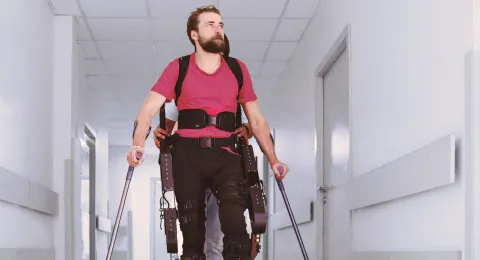LUT has developed new models for care robotics orientation together with Mälardalen University from Sweden and Paderborn University from Germany. Orientation to care robotics is important, because robots are constantly evolving and can perform new types of tasks. Additionally, individuals and the society have needs for information about welfare technology as a phenomenon.
Care robots are service robots that are used primarily in welfare services to support the professionals or the clients. The robots can be, for example, wearable devices, robotic spoons for hand tremor, or pet-like therapy robots.
According to Helinä Melkas, Professor of Industrial Engineering and Management at LUT University, who researches the digitalisation of welfare services, robots and welfare technology in general are not just a matter for one age group.
"For example, wearable devices, exoskeletons, help people of working age to lift heavy loads or keep their hands up to reach out for long periods of time".
Orientation to robotics must take into account the purpose of the robots and their users. In addition to the technical characteristics of the devices, it is good for a care worker to know the opportunities of robotics in developing the overall process of well-being. It is important for the relatives or the patient to know what kind of help the robot brings to the care plan.
It is therefore not enough for the device and its operating instructions to just simply appear in the care unit.
"Exchanging experiences and peer support are also essential. Orientation involves ‘preparing the ground' and co-creation. Together we consider what opportunities the care robot brings to our clients and what it means for our work", Melkas explains.
Society benefits from technology-savvy care professionals
Helinä Melkas would like to see welfare technology and the opportunities associated with it gain a greater foothold in the societal discussion. The image of the industry is often very narrow, although a wide variety of devices such as robots are available to different user groups. The benefits of the technology should also be highlighted.
"For example, in rehabilitation, robots play an important role alongside human physiotherapists. The robots allow for countless repetitions as the patient learns to walk again after a stroke. Regaining the ability to walk has a great positive effect on the patient and the society", Melkas says.
Understanding and increasing the visibility of the long-term benefits could contribute to making welfare technology a clear part of social and healthcare studies. This, in turn, would promote the diffusion of knowledge and understanding in the field.
"It is difficult to predict at what pace care robotics will become more common, but I believe the technology will become more widely used. Shared knowledge is needed at both the individual and societal levels", says Melkas, who has studied the field for 20 years.
The journey to make care robots available to private consumers on the shelves of a department store in Finland, as they already are in Japan, and at an affordable price, still seems a long way off.
"In welfare technology, it is a question of a socio-technical transition at the systemic level. It requires understanding, management and development of the big picture. In addition to orientation, there is also a need for expertise in defining requirements and procurement of care robotics", Melkas sums up.
LUT, Mälardalen University in Sweden and Paderborn University in Germany developed guides to care robot orientation in Finnish, Swedish, German and English as part of the ORIENT project in 2018 - 2020. The project was part of the EU's Joint Programming Initiative - "More Years, Better Lives" (JPI MYBL). Finland's national funder in the JPI MYBL programme was Academy of Finland. ORIENT was one of the projects of LUT's DIGI-USER research platform.
Orientation to care robotics
- Start by understanding: who will conduct the orientation, who are the audience, and why?
- Consider the possibility of a dual role, the learner may also be the instructor
- Apply orientation methods and content to the target group. For a nurse, a robot is a tool, for a rehabilitee it can be a gym instructor or a therapy cat to hold on their lap
- Explain what care robots are. Describe their potential, limitations, and financial and ethical considerations
- Allow sufficient time for orientation
- Share experiences of use and good orientation practices with stakeholders
- Maintain orientation skills
- Discuss care robotics in social interactions, such as conversations with relatives, clients, organisational management, and decision-makers.
Download the Finnish guide to care robot orientation from here
Download the English guide to care robot orientation from here
For Swedish and German see: www.robotorientation.eu
Lisätietoja:



